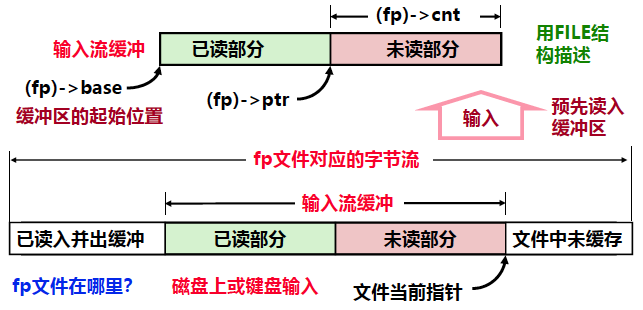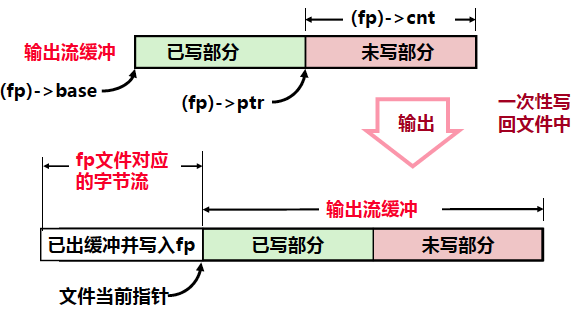C标准I/O库函数基于系统级I/O函数实现,文件是用一个指向特定结构的指针来标识的,这个特定结构就是
FILE结构,它描述了包含文件描述符在内的一组信息。即,它将打开文件抽象为一个类型为FILE的“流”,它是对文件描述符和流缓冲区的抽象。
FILE结构在头文件stdio.h中描述,此外, stdio.h文件中还对其他与标准I/O有关的常量、数据结构、函数等进行了定义。
对文件的操作实际是对文件在内存的缓冲区的操作。
关于FILE结构在VC6中有以下定义
#ifndef _FILE_DEFINED struct _iobuf { char *_ptr; //文件输入的下一个位置 int _cnt; //当前缓冲区的相对位置 char *_base; //指基础位置(即是文件的其始位置) int _flag; //文件标志 int _file; //文件描述符fd int _charbuf; //检查缓冲区状况,如果无缓冲区则不读取 int _bufsiz; //文件缓冲区大小 char *_tmpfname; //临时文件名 }; typedef struct _iobuf FILE; #define _FILE_DEFINED #endif
以下面的简化版程序为例说明:
#define NULL 0 #define EOF (-1) #define BUFSIZ 1024 #define OPEN_MAX 20 /* 最多打开文件数 */ typedef struct _iobuf { int cnt; /*未读写字节数 */ char *ptr; /*下一可读写位置 */ char *base; /* 起始位置 */ int flag; /* 存取模式 */ int fd; /*文件描述符 */ }FILE; extern FILE _iob[OPEN_MAX]; //用数组实现文件缓冲 #define stdin (&_iob[0]) #define stdout (&_iob[1]) #define stderr (&_iob[2]) FILE _iob[OPEN_MAX]={ { 0, ( char * ) 0, ( char * ) 0, _READ, 0 }, //标准输入 { 0, ( char * ) 0, ( char * ) 0, _WRITE, 1 }, //标准输出 { 0, ( char * ) 0, ( char * ) 0, _WRITE | _UNBUF, 2 }, //标准错误 }; enum _flags { _READ= 01, /* file open for reading */ _WRITE= 02, /* file open for writing */ _UNBUF= 04, /* file is unbuffered */ _EOF= 010, /* EOF has occurred on this file */ _ERR= 020 /* error occurred on this file */ };
stdout和stderr都用于标准输出(显示器),但是,stderr存储模式为_WRITE | _UNBUF而stdout存储模式为 _WRITE
因此stdout有缓冲:遇到换行符\n或缓冲满(BUFSIZE=1024)才写文件!
#include <stdio.h> int main(){ fprintf(stdout, “hello "); fprintf(stderr, “world!"); return 0; };
输出结果为:world!hello
#include <stdio.h> int main(){ fprintf(stdout, “hello "); fprintf(stderr, “world!\n"); return 0; };
输出结果为:world!
hello
#include <stdio.h> int main(){ printf(stdout, “hello \n"); fprintf(stderr, “world!"); return 0; };
输出结果为:hello
world!
二者都可重定位到普通文件中!
#include <stdio.h> void main(){ fprintf(stdout, "from stdout\n"); fprintf(stderr, "from stderr\n”); };
./hello > out.txt:stdout送out.txt, stderr送屏幕
./hello 2 > err.txt:stdout送屏幕, stderr送err.txt
./hello > out.txt 2> err.txt:stdout送out.txt,stderr送err.txt
./hello > combine.txt 2>&1:stdout和stderr都送combine.txt
./hello > combine.txt 2> combine.txt:stdout和stderr都送combine.txt
从文件fp中读数据时,FILE中定义的缓冲区为
输入流缓冲(在内存)
首先要从文件fp中读入1024(缓冲大小BUFSIZ=1024)个字节数据到缓存,然后,再按需从缓存中读取1个(如getc)或n个(如fread)字节并返回

向文件fp中写数据时,FILE中定义的缓冲区为
输出流缓冲
先按需不断地向缓存写1个(如putc)或n个(如fwrite)字节,遇到换行符\n或缓存被写满1024(缓冲大小BUFSIZ=1024)个字节,则将缓存内容一次写入文件fp中

在stdio.h中,还有feof()、ferror()、fileno()、getc()、putc()、getchar()、putchar()等宏定义。
系统级I/O函数对文件的标识是文件描述符,C标准I/O库函数中对文件的标识是指向FILE结构的指针,FILE中定义了1024字节的流缓冲区。
使用流缓冲区可使文件内容缓存在用户缓冲区中,而不是每次都直接读/写文件,从而减少执行系统调用次数。系统调用开销很大
int _fillbuf( FILE *); /*第一次调用getc(),需用_fillbuf()填充缓冲区*/ int _flushbuf( int, FILE *); /*遇换行或写缓冲区满,调用其将缓冲内容写文件*/ #define feof(p) (((p) ->flag & _EOF) != 0) #define ferror(p) (((p) ->flag & _ERR) != 0) #define fileno(p) ((p) ->fd) #define getc(p) (--(p)->cnt>=0?(unsigned char)*(p)->ptr++:_fillbuf(p)) /*cnt是未读字符数*/ #define putc(x,p) (--(p)->cnt>=0?*(p)->ptr++=(x):_flushbuf((x),p)) /*cnt是未写字符数*/ #define getchar() getc(stdin) #define putchar(x) putc((x), stdout)
_fillbuf()函数的实现
#include “syscalls.h” /* _fillbuf: allocate and fill input buffer */ int _fillbuf(FILE *fp){ int bufsize; if ((fp->flag & ( _READ | _EOF | _ERR)) != _READ) return EOF; bufsize=(fp->flag & _UNBUF)?1:BUFSIZ; //stderr没有缓冲即bufsize=1 if ((fp -> base == NULL) /* 刚开始,还没有申请缓冲 */ if (( fp -> base = (char *) malloc(bufsize)) == NULL) return EOF; /* 缓冲没有申请到 */ fp->ptr=fp->base; fp->cnt=read(fp->fd,fp->ptr,bufsize); /* cnt<=1024,调用系统调用封装函数进行读文件操作,一次将输入缓冲读满*/ if (--fp->cnt < 0) { /* cnt<=0 */ if (fp->cnt == -1) fp->flag | = _EOF; else fp->flag | = _ERR; fp -> cnt =0; return EOF; } /*一次将输入缓冲读满*/ return (unsigned char)*fp->ptr++; /* 0<cnt<=1023,返回缓冲区当前字节,并ptr加1*/ }
_flushbuf()函数的实现
int _flushbuf(int x, FILE *fp){ unsigned nc; int bufsize; if (fp < _iob || fp > _iob + OPEN_MAX) return EOF; if ((fp->flag & (_WRITE | _ERR)) != _WRITE) return EOF; bufsize=(fp->flag & _UNBUF) ? 1 : BUFSIZ; if (fp->base == NULL) { /* 刚开始,还没有申请缓冲 */ if ((fp->base = (char *)malloc(bufsize)) == NULL) { fp->flag |= _ERR; return EOF; } } else { /* 已存在缓冲,且遇到换行符或缓冲已满 */ nc = fp->ptr-fp->base; if (write(fp->fd,fp->base,nc)!=nc) { fp->flag |= _ERR; return EOF } } fp->ptr=fp->base; /* 缓冲区已空 */ *fp->ptr++=x; fp->cnt=bufsize-1; return x; }
文件复制的两种方法比较:
/* 方式一: getc、putc版本 */ void filecopy(FILE *infp, FILE *outfp){ int c; while ((c=getc(infp)) != EOF) putc(c, outfp); } /* 方式二: read、write版本 */ void filecopy(FILE *infp, FILE *outfp){ char c; while (read(infp->fd,&c,1) != 0) write(outfp->fd,&c,1); }
方式一通过_fillbuf()和_flushbuf()这两个函数一次性读写1024个字节。若文件长度为n,则执行系统调用的次数约为n/512。
对于方式二,若文件长度为n,则需执行2n次系统调用。